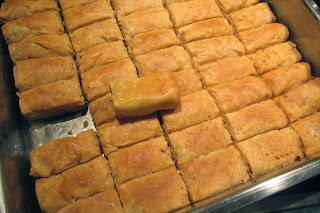In this very long post you will see the very amazing feat of making ultra-thin phyllo from scratch.
It all starts with dough. Here is the recipe.
4 egg yolks
2 whole eggs
1 ¼ demi-tasse cups sunflower seed oil (a demi-tasse holds about 75 ml)
1 ¼ demi-tasse cups milk
1 tsp spoon baking powder
+ little more oil
Add Weizenmehl 405 (most similar to cake flour) until you make a ball of dough. It should be just a bit sticky to the touch. It should not cling to your fingers.
In the video below the dough is found to be a bit too sticky and so more flour is added.
In the video below Lude kneads the dough with a spoon, but you could also use your hands.
Lude forms the dough into small balls. Each weighed 16-17. She made a total of 50 balls.
In the video below you see how she cuts off lumps of dough that are about the right size for each ball.
Here you see how Lude takes each small lump of dough and turns it into a perfect little ball. Sometimes she takes a bit of dough away if she senses the lump is a bit too big.
Look at all these pretty little balls of future phyllo!
Lude places them on a floured tray.
Then she covers the top of tray with a plastic bag and puts the whole tray into another bag.
She places the tray into an oven that has been pre-warmed. To do this, bring the temperature to 50C, then shut off the oven. Let the balls rest in this pre-warmed oven for 30 min.
Or alternatively, keep the tray at room temperature for 2 hours.
Now it's time to make the filling.
Here we crush our nuts with a mortar and pestle. We ground about 300g of walnuts. Lude doesn't use any spices, just walnuts.
We filled another large bowl with cornstarch.
Put four balls into the bowl with cornstarch and make sure they are well dusted.
Here Lude and her daughter team up to make stacks of phyllo. They roll out four balls for each stack.
The last stacks have only three layers.
Sorry, no photos of a stack!
Each stack gets rolled out even larger.
Now Lude places some ground walnuts onto her circle of dough, folds in the edges, and rolls it up.
Here you can watch her daughter do the same.
Each roll gets placed side-by-side into the pan.
She cuts the baklava rolls into individual pieces.
She cuts them completely through to the bottom.
In the meantime she has clarified the butter. To do this she took 500g of butter and melted it. She only uses the fat that rises to the top.
Here Lude spoons the clarified butter all over the inside of the yet-to-be baked pan.
Place the pan in the oven on the highest setting.
When the top starts to brown lower the temp to 150C and bake for 90 min.
Here an individual piece is taken out of the pan.
Look at it!!! What amazing handmade baklava phyllo!
Look again!
Now we have to make the syrup that goes on top. For the syrup mix
1 liter of water
800 g sugar
juice from less than ½ lemon
(Greeks would also add a stick of cinnamon here)
Boil on high heat for 20 min.
Cool 15 min.
Pour evenly over the pan of cooled baklava.
Refrigerate after 3 days.
Here is a piece of baklava that has had the syrup applied.
These are sooo tasty but they get even tastier after they have sat in the refrigerator for a while!!
Here are what the end pieces look like.
Lude makes baklava for her family a few times a year for special occasions. If you have questions feel free to ask!
Note, this post is going up in October 2013 but these photos and videos are all from October 2012.

















































